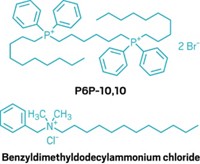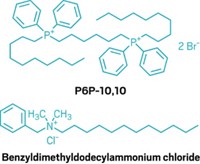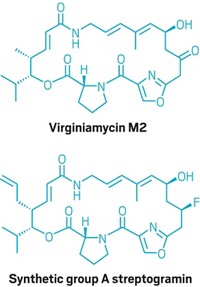Advertisement
Grab your lab coat. Let's get started
Welcome!
Welcome!
Create an account below to get 6 C&EN articles per month, receive newsletters and more - all free.
It seems this is your first time logging in online. Please enter the following information to continue.
As an ACS member you automatically get access to this site. All we need is few more details to create your reading experience.
Not you? Sign in with a different account.
Not you? Sign in with a different account.
ERROR 1
ERROR 1
ERROR 2
ERROR 2
ERROR 2
ERROR 2
ERROR 2
Password and Confirm password must match.
If you have an ACS member number, please enter it here so we can link this account to your membership. (optional)
ERROR 2
ACS values your privacy. By submitting your information, you are gaining access to C&EN and subscribing to our weekly newsletter. We use the information you provide to make your reading experience better, and we will never sell your data to third party members.
Pharmaceuticals
New Antibiotic Disrupts Resistant Superbugs
Drug Development: Researchers synthesize polymyxin-like lipopeptides to kill bacteria that are resistant to all other medications
by Erika Gebel Berg
March 27, 2014

In the fight against harmful bacteria, the last line of defense is beginning to fail. The only drugs that work against certain multidrug-resistant microbes are polymyxins, but some pathogens are beginning to develop resistance to these last-resort therapeutics. Using computer modeling, researchers designed polymyxin-like molecules that can overcome that resistance and serve as a first step toward new medications (ACS Chem. Biol. 2014, DOI: 10.1021/cb500080r).
Polymyxins are natural lipopeptides that bind to lipid A, a component of the cell wall of gram-negative bacteria. The compounds work by disrupting ionic and hydrophobic interactions in the cell envelope, leading to a microbe’s demise, says Kade D. Roberts, a senior research scientist in Jian Li’s laboratory at Monash University, in Australia. When faced with a bacterial infection that doesn’t respond to any other treatment, doctors are left with prescribing a polymyxin. But now, polymyxin-resistant bacteria have evolved with altered forms of lipid A.
Based on a structural model of polymyxin bound to the resistant version of lipid A developed by team member Tony Velkov, the researchers concluded that resistance stems from changes in the lipid that affect hydrophobic interactions with the drug. They used that information to look for modifications that could stabilize the drug-lipid complex and then synthesize a series of new polymyxin-like molecules.
To test their next-generation polymyxins, the researchers grew polymyxin-resistant strains of Pseudomonas aeruginosa, Acinetobacter baumannii, and Klebsiella pneumoniae. Their best compounds kill the bacteria at concentrations as low as 2 mg/L. “It’s a good starting point,” Roberts says, but the compounds aren’t ready for the clinic yet. The researchers are now working on additional polymyxins with greater potency and improved drug properties.





Join the conversation
Contact the reporter
Submit a Letter to the Editor for publication
Engage with us on Twitter